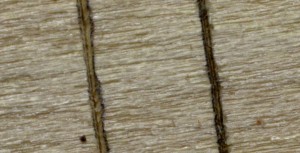We may receive a commission when you use our affiliate links. However, this does not impact our recommendations.
In 19th-century English workshops you could be sacked (fired) for wearing eyeglasses. There are even accounts of how a shop might have a certain phrase that was spoken when the master was about to walk through the workroom. When that phrase was uttered, all the eyeglasses would go into hiding.
I would have been fired in first grade. My eyesight is so poor that teachers worried I was mentally deficient. They didn’t figure out that I was almost blind until I got my hand stuck in a giant metal door that I couldn’t see coming… .
All this is to say that I need all the help I can get when I’m in the shop and trying to follow my layout lines. Using a marking knife is a huge help because it provides a physical point for me to register a tool.
But when you deal with coarse woods such as oak, a knife line might not be enough. In fact, a knife line can look just like a grain line at times. So I use a two-part strategy: I knife in my lines, then color them with a mechanical pencil.
But not just any mechanical pencil.
When microns count, I use an Alvin Draft/Matic No. DM03 mechanical pencil with 0.3mm lead. The lead of this pencil is fine enough to drop into the bottom of a knife line and just darken the floor of the knife line.
Mechanical pencils with thicker leads, such as 0.5mm and 0.7mm, tend to darken the two lips at the top of your knife line. That can actually be handy at times because you can easily split the knife line by sawing, paring or planing away one of the two pencil lines.
The downside to these thicker pencil leads is that they tend to wander, especially when marking coarse woods. Because they mostly ride on top of the wood, they love to hop into a grain line and take a detour.
The 0.3mm lead stays in your knife line and tracks it like crazy. It’s like having a knife that leaves a black knife line in its wake.
Now the 0.3mm pencil is a royal pain. The lead is fragile, so you have to learn to use a light touch when marking your lines. Plus you can’t extend the lead out very far or it will snap. Oh, and because there’s not a lot of lead in 0.3mm, the lead gets used up quickly.
But dang oh dang does it help me see my lines. So for me, it’s worth it.
I bought mine at an artist supply store. If you get one, be sure to get some extra lead while you are there.
And now back to more endless dovetailing on this campaign chest. One assembly down; five to go.
— Christopher Schwarz
Quick. Get your credit card and get over to ShopWoodworking.com right now for a real sale. There are a ton of good books – not junk – that are 50 percent off today and tomorrow. “Furniture in the Southern Style” is half price, as is “The Workbench Design Book,” “Hand Tool Essentials,” “The New Traditional Woodworker” and “Finishing 101.” Click here to see all the books that are on sale.
Here are some supplies and tools we find essential in our everyday work around the shop. We may receive a commission from sales referred by our links; however, we have carefully selected these products for their usefulness and quality.











That is precision. Clean, cool! Brilliant!
Another variation on this: scribe your lines and drag a piece of white chalk over it . You want it to be somewhat powdery so it will fill the low spots in the knife line. Next step, wipe it with a rag and the high spots will come clean and the knife line will stay highlighted.
I tried this with black charcoal powder but i always wound up with smudges on my face from nose scratching. The white doesn’t rat you out as bad.
Yes , the “schwarz effect” . Can’t find .3 online now either. damn.
Just a thought: would a very thin blade on a wood burning pen or soldering iron work? or would it brown the wood past the knife line?
Chris
I agree that marking out is the most important step. You cannot work accurately if you cannot see a line to cut to it.
The very best tip I can give anyone who struggles to see lines clearly, is to use blue tape, as outlined here: http://www.inthewoodshop.com/Furniture/HalfblindDovetailsinJarrah.html
It can change the way in which you mark out and saw dovetails.
Regards from Perth
Derek
So last night on the way home from work I stopped at an art supply store. It’s a big place near a local university with an MFA program. No 0.3mm pencils. None. Zero. Nada.
They’d had a run on them, not a single one in the store. They had probably 30-40 each in .5, .7 and .9. They had 2mm lead holders. They guy was surprised that they’d run through them so quickly. He clearly doesn’t read your blog.
Schwarz effect.
More dang mechanical gadgets to go wrong!
With your pocket knife you can shape a 0.3mm or better chisel point to a regular pencil. Align the chisel point with your knife cut and it will prove more durable than a snapping cylindrical 0.3mm lead.
(From a practical skinflint.)
I’d been thinking about laser surgery for awhile, then at only 55 I was diagnosed with cataracts! Now I have new corrective eyeball lenses, no glasses and I can see like a hawk! But, I have to wear reading glasses all the time….still beats wearing glasses since I was 7.
What do you guys think about latest FW article about just using pencil lines, no scribing??
Chris,
I used 0.3mm lead for a long time before I got fed up with it breaking so often.
I find that 0.5 lead, or just a sharpened regular pencil, blackens the upper edge of the wall of a scribed or knifed groove in the wood. This is much like the line on the left in the photo in your post.
This gives me a good view to split the line with the saw. If the scribing and the pencil work are done with a consistent pressure and angle to the wood, this can give accurate results.
Thanks for relating the story of your myopia. It’s remarkable how children unquestioningly accept the world around them until they are presented with an alternative.
Now, your thoughtful approach to woodworking is appreciated by many people!
Rob
Having learned hand drafting years ago, I still use a drafting lead holder like this:
http://leadholder.com/lh-draft-staedtler-780_series.html#783-right
The leads are 2mm (that’s 2, not 0.2), so quite durable, but using the associated sharpener (called a rotary lead pointer) I can make the tips quite sharp.
The leads come in a variety of hardness ratings, from about 6B to 9H, which is approximately feta cheese to granite. 9H is so hard it will make a knife line and a pencil line at the same time.
Great, now I have to get an Alvin Draft/Matic DM03 to accompany my Graph1000, GraphGear1000, and my Forte Pro II.
On an unrelated note, I *really* didn’t need to find out about this website: http://onelonemanspensandpencils.blogspot.com/
Any other “must have” 0.3mm pencils?
Also, why would you get sacked for wearing glasses?
You might see elsewhere in the Internet some criticism of my use of the term “mentally deficient” above. My phrase is not a euphemistic phrase or an exaggeration. Here’s the real story:
When I was five years old, I was tested by a child psychologist and my parents were told I was “mentally retarded.” I was sent to a special school on Saturdays to help me keep up in the public school.
When I entered first grade, the teachers were very concerned I could not keep up. I seemed bright at times. But I failed miserably at many tasks. There were many long conferences between my parents and the administration about sending me to Bost, the school for special needs kids.
Then in full view of my first-grade teacher Mrs. McKinney I caught my hand in the metal door to the temporary schoolhouse building.
It was like I didn’t see it coming.
I was tested. Blind as a bat. I couldn’t read the chalkboard.
Glasses helped.
Not common, but easy enough to buy on the web, are Japanese pens with very fine points.
My favorite is the Uni-ball Signo DX UM-151 Gel Pen with a .38mm tip. There’s also the Pilot Hi-Tec-C Gel Ink Pen with a .3mm tip.
http://www.jetpens.com/Uni-ball-Signo-DX-UM-151-Gel-Pens-0.38-mm/ct/53
http://www.jetpens.com/Pilot-Hi-Tec-C-Gel-Ink-Pens/ct/27
One of my favorite wood working authors – Neal Stephenson – uses “brushes of combed unicorn mane dipped into ink made of grinding down charcoal slabs fashioned by blind stylite monks from hand-charred fragments of the True Cross” for marking out his knife lines.
Chris,
In order to greatly reduce lead breakage when using a .3 mm pencil (and any other size mechanical pencil) it is imperative to hold it at a 90 deg. angle to the surface while in use. HB lead will be the easiest to work with.
Carl
Bob Flexner for $1. ONE DOLLAR! Ack!
http://www.shopwoodworking.com/product/wood-finishing-101-z9169/giant-january-50-off-sale
Jonathan
=========================================
I have a Staedtler 0.3 mm… but then I ran out of lead. Worked for a while with a Sanford Uniball micro which worked great until the tip clogged. I’m thinking some of the other Staedtler pens might do the trick but I’ve been sidelined from woodworking by general handiwork and parenting for what seems like a long time.
With a title like “The Black Knife” I was totally expecting something about a medieval woodworking assassin. Maybe I’ve been mixing fantasy novels with woodworking tutorials too much…
I really like the Pentel Graph Gear ( http://amzn.to/A72qFD ) line of pencils. The retractable tip has saved me more times than I can count, especially on the 0.3. That sucker is fragile.